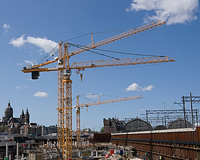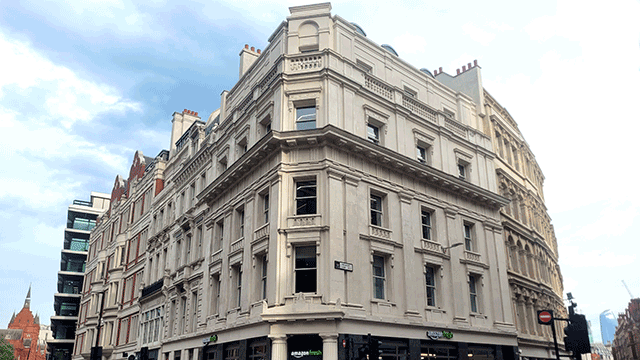It was fitting that in the quarter when Danish toy brand Lego signed for new offices in central London, (25,000 sq ft of refurbished space at Kirbi Real Estate Investment’s New Fetter Place, EC4) there were positive signs that London is building again, and some of it is speculative.
The year got off to a disappointing start, with no major new-builds beginning on site in the first three months. The appearance of hard hats in Q2 was welcome.
The two largest new-builds to start coming out of the ground were Land Securities’ 276,000 sq ft 1 New Street Square, EC4 in Midtown and the Crown Estate’s 135,000 sq ft Quadrant, W1, in the West End. Also in Midtown, Great Portland Estates started work on its 138,000 sq ft 12-14 New Fetter Lane, prelet in its entirety to lawyer Bird & Bird last year, although that will do nothing to ease the supply squeeze. There were no major construction starts at all in Q2 in the City core.
The decision to press the button on a few schemes in Q2 was met with a muted response from London’s agency fraternity, whose general feeling can be summed up as “one construction start does not a summer make”. That reflects a solid but relatively unexciting second quarter. Take-up of over 3m sq ft was up 10% on the previous quarter and 5% on the equivalent quarter last year. Both the City and the West End notched up deals just short of 1m sq ft.
Q2 Central London construction starts (sq ft)
City fringe: 190,000
Docklands: 70,000
Midtown: 360,000 (prelet 140,000)
West End: 240,000 (prelet 40,000)
For the City, that is distinctly unspectacular. For the West End, it was phenomenal. West End take-up was up 74% on the same period last year and at the highest level for four years. Estée Lauder, which signed a much-talked-about prelet for 140,000 sq ft of space at 1 Fitzroy Place, bumped up the figures but also pushed the availability rate to a painful 4.8%, echoing a supply problem across London.
“I just can’t see that there are that many deliverable – and the key is deliverable – schemes that will start speculatively,” admits a central London agent who prefers not to be named. One of the few tipped to go ahead, prelet or not, in Q3 is Helical Bar’s 273,000 sq ft Mitre Square scheme. Other developments, such as Exemplar Properties’ 290,000 sq ft Fruit & Wool Exchange, may not start
until 2015.
Developers are keeping a beady eye on business growth and, despite an increase in take-up, perhaps require further reassurance that economic recovery really is under way. Dan Burn, head of City agency at JLL, says: “The majority of take-up over the last 18 months has been driven by lease events and consolidation, but with many occupiers now considering recruitment and investing in growth, we anticipate competition for space returning to the market, although I suspect that the real impact of this will be seen in six to 12 months’ time.”
As the typical build time for a new office block is between two and three years, some property commentators are suggesting that now is exactly the right time for schemes to start on site. But Jules Hind, partner at Farebrother, points out that the developer pool is smaller than in the last cycle. “This time round, a lot of development is being driven by foreign sovereign wealth or cash and developers aren’t taking so much of a punt, so there aren’t those fringy, compromise developments [we saw in the last cycle], which has kept things relatively tight,” he says.
That is good news for landlords, who continue to see rents move up and incentives in, although less so for occupiers, which may explain why total take-up in Q2, at 3.2m sq ft, was good (and up on the first quarter), but not exceptional. Malcolm Trice, partner at Ingleby Trice, says: “The fact is that take-up is very strong, but it’s not rushing away.”
In fact, it would have been considerably stronger if M&G’s long-anticipated preletting of 323,000 sq ft at Generali’s 120 Fenchurch Street had not missed the quarter-end. Instead, it pushed up the amount of space that went under offer during Q2 to 2.6m sq ft. Add that to deals already in legals and a considerable 3.8m sq ft was under offer across the
capital at the end of June.
“There is an element of deals going through more quickly – the vast majority of what is under offer now will have gone through within a quarter,” says Philip Pearce, central London executive director at Savills. That is likely to include ad agency Omnicom’s subletting of 370,000 sq ft of RBS space at Bankside 2 & 3, SE1 in the Southern Fringe and 150,000 sq ft sublet by JP Morgan to Lloyds Banking Group and EG publisher Reed Elsevier at Alban Gate, EC2.
The attraction of what is technically secondhand space became apparent in the second quarter. Over 60% of total take-up (2m sq ft) was in secondhand offices, compared with about 50% the previous quarter. Despite this, the consensus among central London agents is that there is no trend here and that interest will refocus on brand new stock, although the geographic location of where deals will land is harder to pinpoint, particularly given the cost sensitivity of many occupiers.
The largest amount of available development pipeline space is within W1, although that does not necessarily mean most take-up will follow, points out Dan Bayley, central London managing director at BNP Paribas Real Estate. “There may be more of this kind of stock in the West End, but you have to remember that the pricing is much higher [than the City],” he says.
Wherever tenants decide to go, it is clear that developers are not yet rushing in behind them to create new stock. So, for the second half of 2014 at least, there is more chance of seeing more virtual office space created in Lego’s headquarters in the City than actually on the ground in central London.
Bluffer’s guide: London in 60 seconds
Sweet smell of success – take-up heads west
With over 2m sq ft under offer at the end of the first quarter, an overall rise in take-up in Q2 came as no surprise, although the total figure of a tad north of 3.2m sq ft was not as high as some pundits were expecting. More startling was the fact that the close to 1m sq ft taken in the City core was matched by a similar amount taken in the West End – despite the latter’s availability being around half of the former’s. The preletting of 140,000 sq ft at Exemplar, Aviva Investors and Kaupthing’s 1 Fitzroy Place, W1 development to Estée Lauder was the largest single West End deal this quarter – and one of the biggest in W1 history.
Press the button – real construction starts
With no major construction starts in the first three months of 2014, it was a relief that a number of new-builds got under way in the second quarter, including Land Securities’ speculative redevelopment of 324,000 sq ft at 1 New Street Square, EC4 in Midtown. This development alone made up about 40% of the 1m sq ft that left the starting blocks in Q2, the majority of which did so speculatively. There were no significant starts in
the City core.
Going, going… (part 1) – space under offer is up
Despite an increase in take-up in Q2, the amount of space under offer at the quarter-end actually rose to just short of 3.8m sq ft. Whether this is because, as London office agents have been reporting for some time, deals are still slow completing or the quantum of active demand is rising may become clearer in the second half of the year.
Going, going… (part 2) – development pipeline narrows
The amount of space in the development pipeline to the end of 2016 dropped substantially over the second quarter as several buildings, including British Land and Oxford Properties’ 588,000 sq ft Cheesegrater, EC3, completed. At the end of Q2, less speculatively-built offices under construction were available in the City core than in either the West End or – wait for it – Docklands. Who knew?
May the force be with you
One of the quarter’s top 10 lettings – Salesforce’s additional 50,000 sq ft at Heron Tower, EC2 – caused consternation in the City. In an unusual move, the proposed eponymous renaming of the Gerald Ronson-developed skyscraper to reflect the business software solutions provider’s 17% occupancy of the building was referred to the City of London Corporation following objections from other tenants. An announcement was due as EG went to press.











